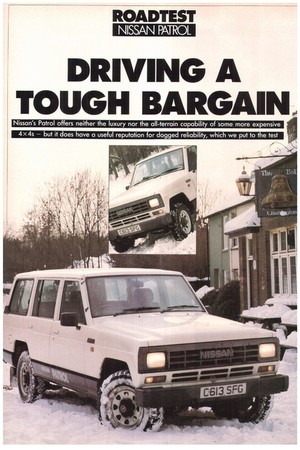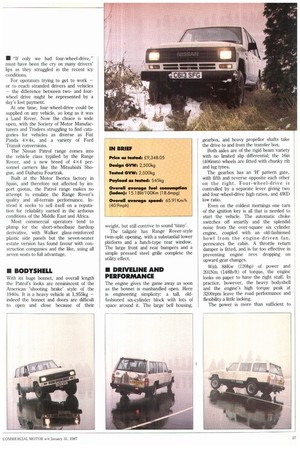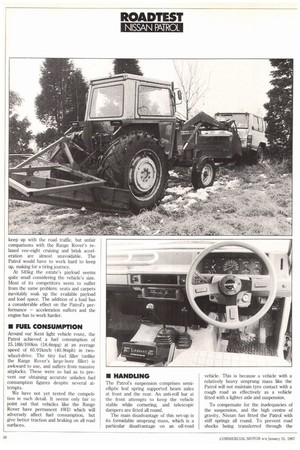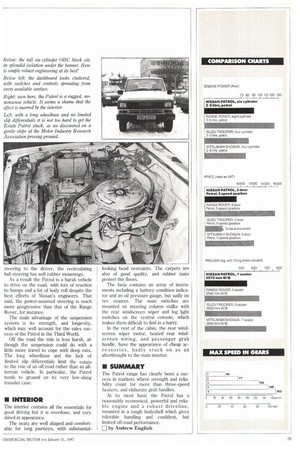DRIVING A
Page 94

Page 95

Page 96

Page 97

If you've noticed an error in this article please click here to report it so we can fix it.
TOUGH BARGAIN,
Nissan's Patrol offers neither the luxury nor the all-terrain capability of Some more expensive 4 x 4s but it does have a useful reputation for dogged reliability, which we put to t e test
• "If only we had four-wheel-drive," must have been the cry on many drivers' lips as they struggled in the recent icy conditions.
For operators trying to get to work — or to reach stranded drivers and vehicles — the difference between twoand fourwheel drive might be represented by a day's lost payment.
At one time, four-wheel-drive could be supplied on any vehicle, so long as it was a Land Rover. Now the choice is wide open, with the Society of Motor Manufacturers and Traders struggling to find catagories for vehicles as diverse as Fiat Panda 4 x4s, and a variety of Ford Transit conversions.
The Nissan Patrol range comes into the vehicle class typified by the Range Rover, and a new breed of 4x4 personnel carriers like the Mitsubishi Shogun, and Daihatsu Fourtrak.
Built at the Motor Iberica factory in Spain, and therefore not affected by import quotas, the Patrol range makes no attempt to emulate the Range Rover's quality and all-terrain performance. Instead it seeks to sell itself on a reputation for reliability earned in the arduous conditions of the Middle East and Africa.
Most commercial operators tend to plump for the short-wheelbase hardtop derivative, with Walker glass-reinforced plastic side panels but the seven-seater estate version has found favour with construction companies and the like, using all seven seats to full advantage.
• BODYSHELL
With its huge bonnet, and overall length the Patrol's looks are reminiscent of the American 'shooting brake' style of the 1940s. It is a heavy vehicle at 1,955kg — indeed the bonnet and doors are difficult to open and close because of their weight, but still contrive to sound `tinny'.
The tailgate has Range Rover-style twin-split opening, with a substantial lower platform and a hatch-type rear window. The large front and rear bumpers and a simple pressed steel grille complete the utility effect.
• DRIVELINE AND PERFORMANCE
The engine gives the game away as soon as the bonnet is manhandled open. Here is engineering simplicity: a tall, oldfashioned six-cylinder block with lots of space around it. The large bell housing, gearbox, and heavy propellor shafts take the drive to and from the transfer box.
Both axles are of the rigid beam variety with no limited slip differential; the 16in (406mm) wheels are fitted with chunky rib and lug tyres.
The gearbox has an 'H' pattern gate, with fifth and reverse opposite each other on the right. Four-wheel-drive is controlled by a separate lever giving two and four-wheel-drive high ratios, and 4WD low ratio.
Even on the coldest mornings one turn of the ignition key is all that is needed to start the vehicle. The automatic choke switches off smartly and the splendid noise from the over-square six cylinder engine, coupled with an old-fashioned howl from the engine-driven fan, permeates the cabin. A throttle return damper is fitted, and is far too effective in preventing engine revs dropping on upward gear changes.
With 881(w (120hp) of power and 201Nm (1481b/ft) of torque, the engine looks on paper to have the right stuff. In practice, however, the heavy bodyshell and the engine's high torque peak at 3200rpm leave the road performance and flexibility a little lacking.
The power is more than sufficient to keep up with the road traffic, but unfair comparisons with the Range Rover's relaxed vee-eight cruising and brisk acceleration are almost unavoidable. The Patrol would have to work hard to keep up, making for a tiring journey.
At 545kg the estate's payload seems quite small considering the vehicle's size. Most of its competitors seem to suffer from the same problem: seats and carpets inevitably soak up the available payload and load space. The addition of a load has a considerable effect on the Patrol's performance — acceleration suffers and the engine has to work harder.
• FUEL CONSUMPTION
Around our Kent light vehicle route, the Patrol achieved a fuel consumption of 15.181it/100km (18.6mpg) at an average speed of 65.91km/h (40.9mph) in twowheel-drive. The tiny fuel filler (unlike the Range Rover's large-bore filler) is awkward to use, and suffers from massive airplocks. These were so bad as to prevent our obtaining accurate unladen fuel consumption figures despite several attempts.
We have not yet tested the competition in such detail, It seems only fair to point out that vehicles like the Range Rover have permanent 4W1..) which will adversely affect fuel consumption, but give better traction and braking on all road surfaces.
• HANDLING
The Patrol's suspension comprises semielliptic leaf spring supported beam axles at front and the rear. An anti-roll bar at the front attempts to keep the vehicle stable while cornering, and telescopic dampers are fitted all round.
The main disadvantage of this set-up is its formidable unsprung mass, which is a particular disadvantage on an off-road vehicle. This is because a vehicle with a relatively heavy unsprung mass like the Patrol will not maintain tyre contact with a rough road as effectively as a vehicle fitted with a lighter axle and suspension.
To compensate for the inadequacies of the suspension, and the high centre of gravity, Nissan has fitted the Patrol with stiff springs all round. To prevent road shocks being transferred through the steering to the driver, the recirculating ball steering has soft rubber mountings.
As a result the Patrol is a harsh vehicle to drive on the road, with lots of reaction to bumps and a lot of body roll despite the best efforts of Nissan's engineers. That said, the power-assisted steering is much more progressive than that of the Range Rover, for instance.
The main advantage of the suspension system is its strength, and longevity, which may well account for the sales success of the Patrol in the Third World.
Off the road the ride is less harsh, although the suspension could do with a Little more travel to cope with deep ruts. The long wheelbase and the lack of limited slip differentials limit the estate to the role of an off-road rather than an allterrain vehicle. In particular, the Patrol tends to ground on its very low-slung transfer case.
M INTERIOR
The interior contains all the essentials for good driving but it is overdone, and very dated in appearance.
The seats are well shaped and comfortable for long journeys, with substantial looking head restraints. The carpets are also of good quality, and rubber mats protect the floors.
The facia contains an array of instruments including a battery condition indicator and an oil pressure gauge, but sadly no rev counter. The main switches are mounted on steering column stalks with the rear windscreen wiper and fog light switches on the central console, which makes them difficult to find in a hurry.
In the rest of the cabin, the rear windscreen wiper motor, heated rear windscreen wiring, and passenger grab handle, have the appearance of cheap accessories, badly stuck on as an afterthought to the main interior.
• SUMMARY
The Patrol range has clearly been a success in markets where strength and reliability count for more than three-speed heaters, and elaborate grab handles.
At its most basic the Patrol has a reasonably economical, powerful and reliable engine and a robust driveline, mounted in a tough bodyshell which gives tolerable handling and confident, but limited off-road performance.
by Andrew English








































































































